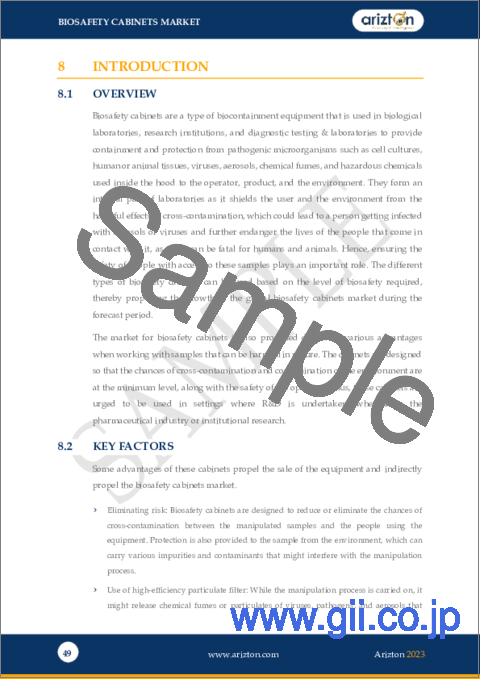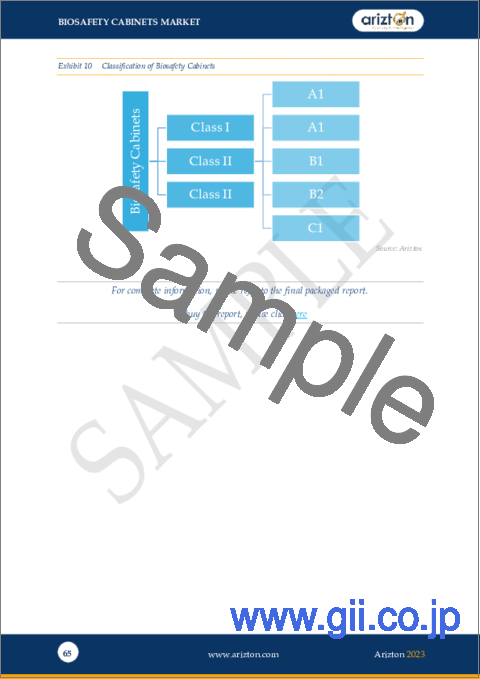|
|
市場調査レポート
商品コード
1286058
バイオセーフティキャビネット市場 - 世界の見通しと予測(2023年~2028年)Biosafety Cabinets Market - Industry Outlook & Forecast 2023-2028 |
||||||
|
|||||||
| バイオセーフティキャビネット市場 - 世界の見通しと予測(2023年~2028年) |
|
出版日: 2023年06月06日
発行: Arizton Advisory & Intelligence
ページ情報: 英文
納期: 即納可能
|
- 全表示
- 概要
- 目次
世界のバイオセーフティキャビネットの市場規模は、予測期間の2022年~2028年に7.36%のCAGRで拡大すると予測されています。
当レポートでは、世界のバイオセーフティキャビネット市場について調査し、市場の概要とともに、製品タイプ別、エンドユーザー別、流通チャネル別、地域別の動向、および市場に参入する企業のプロファイルなどを提供しています。
目次
第1章 調査手法
第2章 調査の目的
第3章 調査プロセス
第4章 範囲と適用範囲
第5章 レポートの前提条件と注意事項
第6章 重要考察
第7章 市場の概要
第8章 イントロダクション
第9章 市場機会と動向
- 感染症のリスクの増加
- 製薬およびバイオ医薬品産業における研究開発投資の増加
- 製薬会社の収益増加
第10章 市場の成長促進要因
第11章 市場の成長抑制要因
第12章 市場情勢
- 市場概要
- 市場規模と予測
- ファイブフォース分析
第13章 製品タイプ
- 市場概要および成長促進要因
- 市場概要
- クラスI
- クラスⅡ
- クラスⅢ
第14章 エンドユーザー
- 市場概要および成長促進要因
- 市場概要
- 製薬会社およびバイオ医薬品企業
- 診断検査と研究所
- 学術研究機関
第15章 流通チャネル
- 市場概要および成長促進要因
- 市場概要
- オフライン
- オンライン
第16章 地域
第17章 北米
第18章 欧州
第19章 アジア太平洋
第20章 中東・アフリカ
第21章 ラテンアメリカ
第22章 競合情勢
第23章 主要企業プロファイル
- THERMO FISHER
- KEWAUNEE SCIENTIFIC
- ESCO LIFESCIENCES GROUP
第24章 他の著名なベンダー
- THE BAKER COMPANY
- AZBIL GROUP
- NUAIRE
- LABCONCO
- GERMFREE LABORATORIES
- CRUMA
- SUZHOU ANTAI AIRTECH CO LTD
- QINGDAO HAIER BIOMEDICAL
- AIR SCIENCE
- BERNER INTERNATIONAL
- CONTAINED AIR SOLUTIONS
- BIOEVOPEAK
- PHOTON CLEAN INC
第25章 レポートの概要
- 重要なポイント
- 戦略的な推奨事項
第26章 定量的要約
第27章 付録
The global biological safety cabinet market is expected to grow at a CAGR of 7.36% from 2022-2028.
MARKET TRENDS & DRIVERS
The Growth in Technological Advancements
With huge advancements in the technology sector, the biosafety cabinet market is also being integrated with technologies that can help detect any leakages or failures of any part of the cabinets. Over the past years, there have been huge developments in the technological integration with these biosafety cabinets. Technological developments such as HEPA filtration systems can filter out 99.9% of the contaminants in the air. These systems have also been integrated with IOT, such as automotive systems shut down and alarm systems that will raise alarms if these systems observe any malfunction or failure of the exhaust systems.
Increased Risk of Communal Diseases
The world has recently witnessed the catastrophe that communicable diseases can cause through the Covid-19 virus. A disease that can be spread from one person to another through various ways, including contact with another person's blood and bodily fluids or breathing in airborne viruses, and being bitten by an insect carrying the pathogen or virus is called a communicable or infectious disease. These diseases can have a variety of severity ranging from asymptomatic (no symptoms) to severe to fatal. Some examples of communicable diseases are HIV, hepatitis A, B, and C, measles, salmonella, and blood-borne diseases. The biosafety cabinets are used in laboratories to study the organisms that transmit such diseases and could be the cause of the spread of communal diseases. Since these pathogens are infectious and can easily spread, utmost care must be taken to handle them. Hence biosafety cabinets are a must in such cases. These cabinets also allow the researchers to analyze the functioning and the process of infection that these organisms inflict.
Development in Biological Testing
The world is currently moving towards modernization and an advanced technological era. These advancements in technology have allowed chemical, biological, and microbiological testing. Further, these tests are conducted to understand and conduct analysis or research on the parameters of a product/subject. The subject in biological testing can be a human, dead or alive, animals and birds. Growing importance is given to biological testing as it is crucial in the early and timely diagnostics of infectious diseases and helps properly manage patients. Biological testing is carried out with substances that can harm the environment and humans, which can also potentially cause infections among them. Hence, such reasons are driving the growth of biological testing facilities across the globe, which will positively impact the biosafety cabinet market as they would be an integral part of the laboratories handling such samples.
SEGMENTATION INSIGHTS
INSIGHTS BY PRODUCT TYPE
The biosafety cabinets or biological safety cabinets are of three major types Class I, II, III. They are assigned to various classes based on the level of safety and protection offered and the level of biosafety measures it can operate. Class II is further sub-segmented into five subcategories. The sub-segments have advanced features such as HEPA filtration systems; they regulate airflow pressure and are safer than class I biosafety cabinets. Class II held most of the global biosafety cabinet market share as they are versatile and used across most facilities.
Segmentation by Product Type
- Class I
- Class II
- Class II A1
- Class II A2
- Class II B1
- Class II B2
- Class II C1
- Class III
INSIGHTS BY END-USER
The global biological safety cabinet market is driven by the safety requirement when handling hazardous substances across various sectors, such as pharmaceutical and biopharmaceuticals, academic research institutes, and diagnostic laboratories. The biosafety cabinets play a critical role in these sectors, enabling them to carry out tests and procedures without contamination. Research institutes are of two types private and university. Both play a very important role in finding new drug compositions and new techniques for diagnostic purposes for various diseases. Pharmaceutical and biopharmaceutical sectors had the majority share of the global biosafety cabinet market, accounting for over 53%. The biotechnology sector is propelling the industry's growth as it is heavily involved with researching and developing therapeutic proteins and drugs through genetic engineering. This sector is important for integrating biology and technology to change or improve a component, or entire biological system, which can benefit human welfare or the industry.
Segmentation by End-User
- Pharmaceutical & Biopharmaceutical Companies
- Diagnostic Laboratories
- Academic Research Institutes
INSIGHTS BY DISTRIBUTION CHANNEL
The global biosafety cabinet market by distribution channels segments as online and offline. The offline method is one of the oldest techniques that are in existence that is utilized to get a company's products to their potential customer. In 2022, the offline distribution channel had the highest global biosafety cabinet market share. Factors such as broader reach in areas that lack better connectivity and high consumer trust associated with touching and experiencing the quality of products are driving the growth of this segment. Further, the online distribution channel allows manufacturers and vendors to have multichannel campaigns across various channels, such as third-party retailers and direct websites. Online shopping entails online buying, mobile ordering, and digital media. High penetration rates of connectivity are expected to grow the online multichannel platforms' visibility during the forecasted period, thus increasing the online presence of the vendors.
Segmentation by Distribution Channel
- Offline
- Online
GEOGRAPHICAL ANALYSIS
North America holds the largest global biosafety cabinet market share, accounting for over 38% in 2022. The market is majorly driven by the presence of pharmaceutical, research, and development institutes and laboratories for diagnostic purposes. The region of North America majorly consists of developed countries, and the U.S. is the major contributor to their economy. According to Torreya, in 2020, U.S pharmaceutical companies raised USD 120.3 billion in Initial Public Offering, the highest in recent years. Such reasons are projected to propel the growth of biosafety cabinets in the region during the forecasted period.
Segmentation by Geography
- North America
- The U.S.
- Canada
- Europe
- Germany
- The U.K.
- France
- Italy
- Spain
- APAC
- China
- Japan
- India
- Australia
- Middle East & Africa
- Saudi Arabia
- South Africa
- UAE
- Latin America
- Brazil
- Mexico
COMPETITIVE LANDSCAPE
The global biosafety cabinet market needs to be more cohesive and have many national and international participants. These players have been continuously focusing on innovation and product differentiation techniques. They also rely on these factors to capture higher market shares. It is also expected that with more favorable financial and technological capabilities will be able to invent and launch products that are technologically integrated, which might threaten the products of their competitors and could make their products and services non-competitive.
Key Company Profiles
- Thermo Fisher
- Kewaunee Scientific
- Esco Lifesciences Group
Other Prominent Vendors
- The Baker Company
- Azbil Group
- NuAire
- Labconco
- Germfree Laboratories
- Cruma
- Suzhou Antai Airtech Co Ltd
- Qingdao Haier Biomedical
- Air Science
- Berner International
- Contained Air Solutions
- Bioevopeak
- Photon Cleantech Inc
KEY QUESTIONS ANSWERED:
- 1. How big is the biosafety cabinet market?
- 2. What is the growth rate of the global biosafety cabinet market?
- 3. Which region dominates the global biosafety cabinet market share?
- 4. What are the significant trends in the biosafety cabinet market?
- 5. Who are the key players in the global biosafety cabinet market?
TABLE OF CONTENTS
1 RESEARCH METHODOLOGY
2 RESEARCH OBJECTIVES
3 RESEARCH PROCESS
4 SCOPE & COVERAGE
- 4.1 MARKET DEFINITION
- 4.1.1 INCLUSIONS
- 4.1.2 EXCLUSIONS
- 4.1.3 MARKET ESTIMATION CAVEATS
- 4.2 BASE YEAR
- 4.3 SCOPE OF THE STUDY
- 4.3.1 MARKET SEGMENTATION BY PRODUCT TYPE
- 4.3.2 MARKET SEGMENTATION BY END-USER
- 4.3.3 MARKET SEGMENTATION BY DISTRIBUTION CHANNEL
- 4.3.4 MARKET SEGMENTATION BY GEOGRAPHY
5 REPORT ASSUMPTIONS & CAVEATS
- 5.1 KEY CAVEATS
- 5.2 CURRENCY CONVERSION
- 5.3 MARKET DERIVATION
6 PREMIUM INSIGHTS
- 6.1 OVERVIEW
- 6.1.1 GROWTH IN TECHNOLOGICAL ADVANCES
- 6.1.2 INCREASED RISK OF COMMUNICABLE DISEASES
- 6.1.3 DEVELOPMENT IN BIOLOGICAL TESTING
- 6.2 MARKET LANDSCAPE
- 6.2.1 PRODUCT TYPE
- 6.2.2 END-USER
- 6.2.3 COMPETITIVE LANDSCAPE
7 MARKET AT A GLANCE
8 INTRODUCTION
- 8.1 OVERVIEW
- 8.2 KEY FACTORS
- 8.3 BIOSAFETY LEVELS
- 8.3.1 BIOSAFETY LEVEL 1
- 8.3.2 BIOSAFETY LEVEL 2
- 8.3.3 BIOSAFETY LEVEL 3
- 8.3.4 BIOSAFETY LEVEL 4
9 MARKET OPPORTUNITIES & TRENDS
- 9.1 INCREASE IN RISK OF COMMUNICABLE DISEASES
- 9.2 INCREASE IN R&D INVESTMENTS IN PHARMACEUTICAL & BIOPHARMACEUTICAL INDUSTRY
- 9.3 INCREASE IN REVENUES OF PHARMACEUTICAL COMPANIES
10 MARKET GROWTH ENABLERS
- 10.1 REGULATION IN PLACE BY ORGANIZATIONS
- 10.2 RAPID DEVELOPMENT IN BIOLOGICAL TESTING
- 10.3 RAPID GROWTH IN TECHNOLOGICAL DEVELOPMENT
11 MARKET RESTRAINTS
- 11.1 FLUCTUATION IN PRICES OF RAW MATERIALS AND SUPPLY CHAIN
- 11.2 SHORTAGE OF SKILLED LABOR
12 MARKET LANDSCAPE
- 12.1 MARKET OVERVIEW
- 12.2 MARKET SIZE & FORECAST
- 12.3 FIVE FORCES ANALYSIS
- 12.3.1 THREAT OF NEW ENTRANTS
- 12.3.2 BARGAINING POWER OF SUPPLIERS
- 12.3.3 BARGAINING POWER OF BUYERS
- 12.3.4 THREAT OF SUBSTITUTES
- 12.3.5 COMPETITIVE RIVALRY
13 PRODUCT TYPE
- 13.1 MARKET SNAPSHOT & GROWTH ENGINE
- 13.2 MARKET OVERVIEW
- 13.3 CLASS I
- 13.3.1 MARKET OVERVIEW
- 13.3.2 MARKET SIZE & FORECAST
- 13.3.3 MARKET BY GEOGRAPHY
- 13.4 CLASS II
- 13.4.1 MARKET OVERVIEW
- 13.4.2 MARKET SIZE & FORECAST
- 13.4.3 MARKET BY GEOGRAPHY
- 13.4.4 CLASS II A1
- 13.4.5 CLASS II A1 MARKET SIZE & FORECAST
- 13.4.6 CLASS II A1 MARKET BY GEOGRAPHY
- 13.4.7 CLASS II A2
- 13.4.8 CLASS II A2 MARKET SIZE & FORECAST
- 13.4.9 CLASS II A2 MARKET BY GEOGRAPHY
- 13.4.10 CLASS II B1
- 13.4.11 CLASS II B1 MARKET SIZE & FORECAST
- 13.4.12 CLASS II B1 MARKET BY GEOGRAPHY
- 13.4.13 CLASS II B2
- 13.4.14 CLASS II B2 MARKET SIZE & FORECAST
- 13.4.15 CLASS II B2 MARKET BY GEOGRAPHY
- 13.4.16 CLASS II C1
- 13.4.17 CLASS II C1 MARKET SIZE & FORECAST
- 13.4.18 CLASS II C1 MARKET BY GEOGRAPHY
- 13.5 CLASS III
- 13.5.1 MARKET OVERVIEW
- 13.5.2 MARKET SIZE & FORECAST
- 13.5.3 MARKET BY GEOGRAPHY
14 END-USER
- 14.1 MARKET SNAPSHOT & GROWTH ENGINE
- 14.2 MARKET OVERVIEW
- 14.3 PHARMACEUTICAL & BIOPHARMACEUTICAL COMPANIES
- 14.3.1 MARKET OVERVIEW
- 14.3.2 MARKET SIZE & FORECAST
- 14.3.3 MARKET BY GEOGRAPHY
- 14.4 DIAGNOSTIC TESTING & LABORATORIES
- 14.4.1 MARKET OVERVIEW
- 14.4.2 MARKET SIZE & FORECAST
- 14.4.3 MARKET BY GEOGRAPHY
- 14.5 ACADEMIC RESEARCH INSTITUTES
- 14.5.1 MARKET OVERVIEW
- 14.5.2 MARKET SIZE & FORECAST
- 14.5.3 MARKET BY GEOGRAPHY
15 DISTRIBUTION CHANNEL
- 15.1 MARKET SNAPSHOT & GROWTH ENGINE
- 15.2 MARKET OVERVIEW
- 15.3 OFFLINE
- 15.3.1 MARKET OVERVIEW
- 15.3.2 DEALERS & DISTRIBUTION
- 15.3.3 SPECIALTY STORES
- 15.3.4 MARKET SIZE & FORECAST
- 15.3.5 MARKET BY GEOGRAPHY
- 15.4 ONLINE
- 15.4.1 MARKET OVERVIEW
- 15.4.2 DIRECT SALES
- 15.4.3 THIRD-PARTY SALES
- 15.4.4 MARKET SIZE & FORECAST
- 15.4.5 MARKET BY GEOGRAPHY
16 GEOGRAPHY
- 16.1 MARKET SNAPSHOT & GROWTH ENGINE
- 16.2 GEOGRAPHIC OVERVIEW
17 NORTH AMERICA
- 17.1 MARKET OVERVIEW
- 17.2 MARKET SIZE & FORECAST
- 17.3 PRODUCT TYPE
- 17.3.1 MARKET SIZE & FORECAST
- 17.4 CLASS II
- 17.4.1 CLASS II: MARKET SIZE & FORECAST
- 17.5 END-USER
- 17.5.1 MARKET SIZE & FORECAST
- 17.6 DISTRIBUTION CHANNEL
- 17.6.1 MARKET SIZE & FORECAST
- 17.7 KEY COUNTRIES
- 17.7.1 US: MARKET SIZE & FORECAST
- 17.7.2 CANADA: MARKET SIZE & FORECAST
18 EUROPE
- 18.1 MARKET OVERVIEW
- 18.2 MARKET SIZE & FORECAST
- 18.3 PRODUCT TYPE
- 18.3.1 MARKET SIZE & FORECAST
- 18.4 CLASS II
- 18.4.1 CLASS II: MARKET SIZE & FORECAST
- 18.5 END-USER
- 18.5.1 MARKET SIZE & FORECAST
- 18.6 DISTRIBUTION CHANNEL
- 18.6.1 MARKET SIZE & FORECAST
- 18.7 KEY COUNTRIES
- 18.7.1 GERMANY: MARKET SIZE & FORECAST
- 18.7.2 UK: MARKET SIZE & FORECAST
- 18.7.3 FRANCE: MARKET SIZE & FORECAST
- 18.7.4 ITALY: MARKET SIZE & FORECAST
- 18.7.5 SPAIN: MARKET SIZE & FORECAST
19 APAC
- 19.1 MARKET OVERVIEW
- 19.2 MARKET SIZE & FORECAST
- 19.3 PRODUCT TYPE
- 19.3.1 MARKET SIZE & FORECAST
- 19.4 CLASS II
- 19.4.1 CLASS II: MARKET SIZE & FORECAST
- 19.5 END-USER
- 19.5.1 MARKET SIZE & FORECAST
- 19.6 DISTRIBUTION CHANNEL
- 19.6.1 MARKET SIZE & FORECAST
- 19.7 KEY COUNTRIES
- 19.7.1 CHINA: MARKET SIZE & FORECAST
- 19.7.2 JAPAN: MARKET SIZE & FORECAST
- 19.7.3 INDIA: MARKET SIZE & FORECAST
- 19.7.4 AUSTRALIA: MARKET SIZE & FORECAST
20 MIDDLE EAST & AFRICA
- 20.1 MARKET OVERVIEW
- 20.2 MARKET SIZE & FORECAST
- 20.3 PRODUCT TYPE
- 20.3.1 MARKET SIZE & FORECAST
- 20.4 CLASS II
- 20.4.1 CLASS II: MARKET SIZE & FORECAST
- 20.5 END-USER
- 20.5.1 MARKET SIZE & FORECAST
- 20.6 DISTRIBUTION CHANNEL
- 20.6.1 MARKET SIZE & FORECAST
- 20.7 KEY COUNTRIES
- 20.7.1 SAUDI ARABIA: MARKET SIZE & FORECAST
- 20.7.2 SOUTH AFRICA: MARKET SIZE & FORECAST
- 20.7.3 UAE: MARKET SIZE & FORECAST
21 LATIN AMERICA
- 21.1 MARKET OVERVIEW
- 21.2 MARKET SIZE & FORECAST
- 21.3 PRODUCT TYPE
- 21.3.1 MARKET SIZE & FORECAST
- 21.4 CLASS II
- 21.4.1 MARKET SIZE & FORECAST
- 21.5 END-USER
- 21.5.1 MARKET SIZE & FORECAST
- 21.6 DISTRIBUTION CHANNEL
- 21.6.1 MARKET SIZE & FORECAST
- 21.7 KEY COUNTRIES
- 21.7.1 BRAZIL: MARKET SIZE & FORECAST
- 21.7.2 MEXICO: MARKET SIZE & FORECAST
22 COMPETITIVE LANDSCAPE
- 22.1 COMPETITION OVERVIEW
23 KEY COMPANY PROFILES
- 23.1 THERMO FISHER
- 23.1.1 BUSINESS OVERVIEW
- 23.1.2 PRODUCT OFFERINGS
- 23.1.3 KEY STRATEGIES
- 23.1.4 KEY STRENGTHS
- 23.1.5 KEY OPPORTUNITIES
- 23.2 KEWAUNEE SCIENTIFIC
- 23.2.1 BUSINESS OVERVIEW
- 23.2.2 PRODUCT OFFERINGS
- 23.2.3 KEY STRATEGIES
- 23.2.4 KEY STRENGTHS
- 23.2.5 KEY OPPORTUNITIES
- 23.3 ESCO LIFESCIENCES GROUP
- 23.3.1 BUSINESS OVERVIEW
- 23.3.2 PRODUCT OFFERINGS
- 23.3.3 KEY STRATEGIES
- 23.3.4 KEY STRENGTHS
- 23.3.5 KEY OPPORTUNITIES
24 OTHER PROMINENT VENDORS
- 24.1 THE BAKER COMPANY
- 24.1.1 BUSINESS OVERVIEW
- 24.1.2 PRODUCT OFFERINGS
- 24.2 AZBIL GROUP
- 24.2.1 BUSINESS OVERVIEW
- 24.2.2 PRODUCT OFFERINGS
- 24.3 NUAIRE
- 24.3.1 BUSINESS OVERVIEW
- 24.3.2 PRODUCT OFFERINGS
- 24.4 LABCONCO
- 24.4.1 BUSINESS OVERVIEW
- 24.4.2 PRODUCT OFFERINGS
- 24.5 GERMFREE LABORATORIES
- 24.5.1 BUSINESS OVERVIEW
- 24.5.2 PRODUCT OFFERINGS
- 24.6 CRUMA
- 24.6.1 BUSINESS OVERVIEW
- 24.6.2 PRODUCT OFFERINGS
- 24.7 SUZHOU ANTAI AIRTECH CO LTD
- 24.7.1 BUSINESS OVERVIEW
- 24.7.2 PRODUCT OFFERINGS
- 24.8 QINGDAO HAIER BIOMEDICAL
- 24.8.1 BUSINESS OVERVIEW
- 24.8.2 PRODUCT OFFERINGS
- 24.9 AIR SCIENCE
- 24.9.1 BUSINESS OVERVIEW
- 24.9.2 PRODUCT OFFERINGS
- 24.10 BERNER INTERNATIONAL
- 24.10.1 BUSINESS OVERVIEW
- 24.10.2 PRODUCT OFFERINGS
- 24.11 CONTAINED AIR SOLUTIONS
- 24.11.1 BUSINESS OVERVIEW
- 24.11.2 PRODUCT OFFERING
- 24.12 BIOEVOPEAK
- 24.12.1 BUSINESS OVERVIEW
- 24.12.2 PRODUCT OFFERING
- 24.13 PHOTON CLEAN INC
- 24.13.1 BUSINESS OVERVIEW
- 24.13.2 PRODUCT OFFERING
25 REPORT SUMMARY
- 25.1 KEY TAKEAWAYS
- 25.2 STRATEGIC RECOMMENDATIONS
26 QUANTITATIVE SUMMARY
- 26.1 MARKET BY GEOGRAPHY
- 26.2 NORTH AMERICA
- 26.2.1 PRODUCT TYPE: MARKET SIZE & FORECAST
- 26.2.2 CLASS II: MARKET SIZE & FORECAST
- 26.2.3 END-USER: MARKET SIZE & FORECAST
- 26.2.4 DISTRIBUTION CHANNEL: MARKET SIZE & FORECAST
- 26.3 EUROPE
- 26.3.1 PRODUCT TYPE: MARKET SIZE & FORECAST
- 26.3.2 CLASS II: MARKET SIZE & FORECAST
- 26.3.3 END-USER: MARKET SIZE & FORECAST
- 26.3.4 DISTRIBUTION CHANNEL: MARKET SIZE & FORECAST
- 26.4 APAC
- 26.4.1 PRODUCT TYPE: MARKET SIZE & FORECAST
- 26.4.2 CLASS II: MARKET SIZE & FORECAST
- 26.4.3 END-USER: MARKET SIZE & FORECAST
- 26.4.4 DISTRIBUTION CHANNEL: MARKET SIZE & FORECAST
- 26.5 MIDDLE EAST & AFRICA
- 26.5.1 PRODUCT TYPE: MARKET SIZE & FORECAST
- 26.5.2 CLASS II: MARKET SIZE & FORECAST
- 26.5.3 END-USER: MARKET SIZE & FORECAST
- 26.5.4 DISTRIBUTION CHANNEL: MARKET SIZE & FORECAST
- 26.6 LATIN AMERICA
- 26.6.1 PRODUCT TYPE: MARKET SIZE & FORECAST
- 26.6.2 CLASS II: MARKET SIZE & FORECAST
- 26.6.3 END-USER: MARKET SIZE & FORECAST
- 26.6.4 DISTRIBUTION CHANNEL: MARKET SIZE & FORECAST
27 APPENDIX
- 27.1 ABBREVIATIONS





